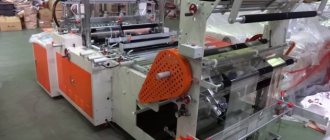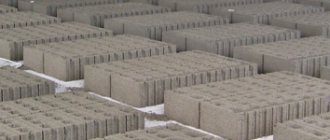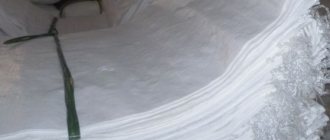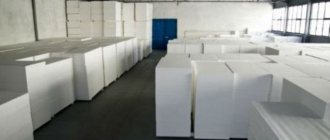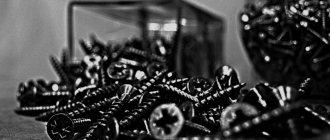Organization of a production workshop
It is optimal if the production facility is located in an industrial zone or outside the city limits. When choosing a location, it is necessary to take into account factors of transport accessibility and the availability of high-quality access roads. To organize production, you will need a structure with an area of 200 m², a ceiling height of at least 10 m with an electrical network (380 V), water supply and drainage systems.
The interior of the building should be divided into several zones:
- manufacturing facility;
- areas for storing raw materials and finished products;
- WC;
- premises for employees.
Given the large dimensions and high level of heat production during the production process, the workshop must be equipped with powerful air conditioners and a modern fire protection system. Warehouses will require the installation of a heating system to maintain positive temperatures in winter.
Welding tool for polyethylene pipes (butt)
Butt welding with a heated tool (HT) is a method of connecting PE pipes, which is most often used when installing communications of any size. The machine for welding polyethylene pipes using this technology consists of:
- heater;
- mechanical or hydraulic centering mechanism;
- trimmer;
- additional units depending on the model.
Butt welding equipment for welding polyethylene pipes generally works according to the following scheme: the ends of the fused pipes are heated, connected and held until the seam has completely cooled. Welding tools for polyethylene pipes vary in:
- range of working diameters;
- ensured connection quality;
- technical parameters;
- size and weight;
- price, manufacturer, etc.
The welding machine for polyethylene can be manual, semi-automatic and automatic.
A hand-held soldering iron for polyethylene pipes is used when working with small-section intra-house communications. All operations are performed manually, the parameters of the welded joint are determined using special tables.
A semi-automatic welding machine for PE pipes allows, with manual provision of welding parameters, automatic connection of pipes using a hydraulic centralizer.
Automatic welding equipment for polyethylene pipes operates on the basis of software without human intervention, which ensures exceptional quality and safety of work.
Recruitment
To organize the uninterrupted operation of the enterprise in two shifts, you will need to hire at least 6 workers (3 people per shift), an accountant, a process engineer, two operators servicing the operation of the machines, as well as several auxiliary workers and at least two security guards. On average, the cost of paying a team requires $6,000.
The production of HDPE pipes is classified as technically complex. This means that to open a business you will need to obtain permits from the local administration, State Energy Supervision Authority, Sanitary and Epidemiological Station, and the fire inspectorate. The priority form of enterprise registration is LLC.
Vacuum forming cooling bath
| Vacuum forming system | |
| Water cooling system | |
| Water level control system | |
| Water temperature control system | |
| Length | 6000 mm |
| Bath material | SUS304 steel |
| Filter | Tin-Bronze |
| Cooling method | Spray filler |
| Water pump power | 4kW*1 |
| Vacuum pump power | 3kW*1 |
| Vacuum degree | 0.03 – 0.06 MPa |
| Adjustments | |
| Back and forth | +/- 600mm (Servomotor) |
| Up down | +/- 50mm (Manual control) |
Equipment for the production of HDPE pipes
The market offers a wide selection of equipment for the production of HDPE pipes of domestic and foreign brands. It is natural that the amount of investment for the purchase of Russian units is somewhat lower. You can also save money by purchasing used lines from foreign brands, the cost of which will be about 1.7-2 million rubles. Equipment of the highest price category, regardless of the country of origin, will require investments in the amount of 3-4 million rubles.
A standard HDPE pipe production line includes the following components:
- dryers for granulated raw materials;
- automatic loader;
- screw (in priority), disk or combined extruder;
- baths for cooling workpieces;
- vacuum calibrator;
- conveyor;
- coronator;
- planetary saw for cutting pipes;
- unit for product labeling;
- auto stacker;
- automated control system.
This line makes it possible to produce HDPE water supply pipes, products for gas transportation and casings for laying cables.
Equipment for welding polyethylene pipes
Today, polyethylene pipes are used for laying gas and water supply communications, sewer networks, as protective ducts for electrical wiring and communication cables, and in technological lines of industrial enterprises.
This is due to the performance characteristics of PE pipes, which are not subject to corrosion, are environmentally friendly, strong and durable, have a low weight and a wide range of operating temperatures, restore their shape with minor deformations, and do not form layers on their inner surface, which are typical for metal pipes.
PE pipes allow you to carry out any complex installation scheme, and two technologies for connecting them are used:
- welding of parts with embedded heaters (ZH);
- butt welding with a heated tool (NI).
It is clear that the polyethylene welding equipment used during the installation process plays an important role in ensuring the reliability of the PE pipeline.
Technology for manufacturing HDPE pipes + Video of how they are made
The production of pressure water pipes is carried out in accordance with GOST 18599-2001, products used for gas transportation must be made of PE 100 and comply with GOST R 50838-95.
The production process is based on extrusion technology. The raw material is placed in an extruder and softened there, and then formed into pipes of a given diameter using dies and cooled.
The technological cycle includes several stages:
- the raw material is placed in a storage hopper, then into an extruder, where it is gradually heated with constant stirring;
- moving to the extruder head, where the shape of the future product is formed, the mass passes through a series of cylinders;
- the workpiece is fed into a vacuum calibrator to check the specified parameters and partial cooling;
- the almost finished pipe is alternately placed in several cooling baths and reaches the set temperature;
- pipes are fed onto a conveyor for cutting using a planetary saw;
- The products are marked, placed in coils and sent to the storage area.
The key component of the entire line is the extruder die. The calibration of the dimensions of finished products depends on the characteristics of this unit.
What does the extrusion process look like:
What equipment is needed for the job?
In order to produce the presented material, you need a machine for the production of polyethylene pipes, and more than one. So, you will need:
- a device with which granules will be constantly fed into the extruder hopper;
- an apparatus in which plasticization of raw materials and its enrichment with various additives is carried out;
- a vacuum apparatus that calibrates the workpiece;
- cooling baths;
- the mechanism by which the workpiece is moved along the production line;
- cutting apparatus;
- ultrasonic control device for dimensional accuracy of finished elements;
- Remote Control.
In principle, the polyethylene pipe production line does not require any other machinery.
Investments and profitability of this business
To effectively start a business producing HDPE pipes, you will need at least 9 million rubles or 140 thousand dollars. This amount already includes funds for the purchase of equipment, paperwork and permits, renovation of premises, employee salaries and raw material costs for 6 months, rent, utility bills, tax deductions and expenses for promoting the new brand.
The success of any production activity is based on many factors, including the presence of consumers and suppliers of raw materials in close proximity, product range, the effectiveness of the chosen advertising strategy, and others.
As for the cost of the final product, it depends on the type and dimensions of the products.
Rate this page: 2 ratings, average: 3.00
- #: Business for men
- Production
- Construction materials
Commercial offer
Extrusion line for the production of PE pipes with a diameter from 63 to 160 mm.
We are pleased to present to you extrusion lines made according to the instructions of our company’s engineers. In the formation of these lines, many years of experience in working with Russian raw materials - primary and secondary, working and operating conditions were taken into account. All components are easily replaceable and repairable. Extruder units allow for maximum productivity on various types and diameters of pipes. Almost all electronic components used are European, the main components are made of high-quality metals, which ensures long-term operation of the equipment. The low cost is due to assembly in China, at a factory that has CE quality certificates and its own design developments. Almost all extruder components are manufactured at this plant, which makes it possible to guarantee full warranty coverage. Our company offers selection, installation, installation and training on equipment for the production of plastic pipes (PVC, HDPE). We provide full warranty support for 12 months from the date of commissioning of the line and post-warranty service.
Before and after production preparation of PE pipes
Quality control
The production of polyethylene pipes is not limited to manufacturing alone. The workshop must ensure end-to-end quality control of pipes. Thus, incoming control of consumables is carried out on the basis of the accompanying documents attached to them - passports, quality certificates.
Directly during production, the functions of quality control fall on the operator, who conducts it on the basis of data from measuring instruments and equipment.
Advice!
In addition, a visual inspection of the internal and external surfaces of the finished product should be carried out for sagging, cavities, and scratches.
Each batch of polyethylene water pipes is subject to mandatory inspection by the technical control service to ensure product compliance with GOST requirements.
Transportation and storage of PE pipes
Rules for transportation and storage of pipes:
- Pipes are subject to transportation by any means of transport in accordance with the rules for the carriage of goods.
- When transporting polyethylene pipes by rail in covered cars, the weight of the coil, package, or coil of pipe should not exceed 1.25 tons, while the length of the pipes should not exceed 5.5 m.
- When transporting polyethylene sewer or water pipes by water transport, it is recommended to use load-bearing packaging means.
- When storing or transporting, polyethylene pipes (for heating, water supply, sewerage) should be laid on a flat surface without any sharp corners nearby to avoid damage to the products.
Polyethylene pipe warehouse
- Pipe storage is carried out in accordance with conditions 5 (OZH4) of section 10 of GOST 15150. In addition, it is allowed to store pipes under conditions 8 (OZH3) for no more than a year, including the period of storage at the manufacturer.
Advice! The height of the stack should be no more than 2 m if pipes are planned to be stored for a period of more than 2 months, but if up to 2 months - no more than 3 m.
Due to the presence of a large number of manufacturers of polyethylene pipes on the market, you should be especially careful when choosing products, especially Chinese and domestic production. A quality certificate and the absence of visible defects on the purchased products will guarantee that the pipes will serve under operating conditions for at least the stated period.
Did you like the article? Subscribe to our Yandex.Zen channel
Transportation and storage rules
To avoid damage to polyethylene pipes, an important aspect is how the product is transported to the consumer and how its storage is organized.
Rules that must be followed so that the quality of the products does not suffer:
- Pipes should be stored in their original packaging, but if this is not provided by the manufacturer, it is important to take care to protect the products from exposure to sunlight and contamination; it is recommended to use storage facilities.
- The bays are laid on top of each other using special wooden spacers or pallets, which should be placed at a distance of no more than one meter.
- Do not throw, avoid impacts during loading, and do not move the coils by dragging, so as not to damage mechanically weak products. Rolling along the joists is acceptable.
- Loading operations should not be carried out at low air temperatures. If the thermometer scale drops below - 20°C, the pipes may suffer. Low temperatures make polyethylene brittle and vulnerable. Factory packaging can somehow save the situation, but it’s better not to risk it.
Prices for HDPE pipes in Moscow
16 20 25 32 40 50 63 75 90 110 160 200 225
Pipes are made from low-pressure medium-density polyethylene (HDPE). The method of continuous screw extrusion is used in production. Low cost, low installation costs, as well as low operating costs make HDPE pipes very popular all over the world. Their technical characteristics may vary, which determines the efficiency, reliability and durability of communications.
Functional and unpretentious HDPE pipes are widely used in everyday life. You can buy HDPE pipes for installation:
- indoor water supply,
- irrigation systems,
- low-pressure water supply systems,
- gravity sewer
- HDPE pipes are indispensable for transporting chemicals due to their resistance to their aggressive effects.
Mixer
| Model | TVM-500 |
| Power | 4 kW |
| Network connection | 3phase/380V 50Hz |
| Load capacity | 500 l |
| Dimensions(mm) | 1500x1500x1750 |
| Weight | 750 kg |
| Cost including VAT 18% | 6310 USD |
Cooling bath
| Water cooling system | |
| Water level control system | |
| Length | 6000 mm |
| Bath material | |
| Frame | SUS304 steel |
| Cooling method | Spray filler |
| Water pump power | 3kW*1 |
| Up down | +/- 50mm (Manual control) |
| Elktronika | Made in Japan |
